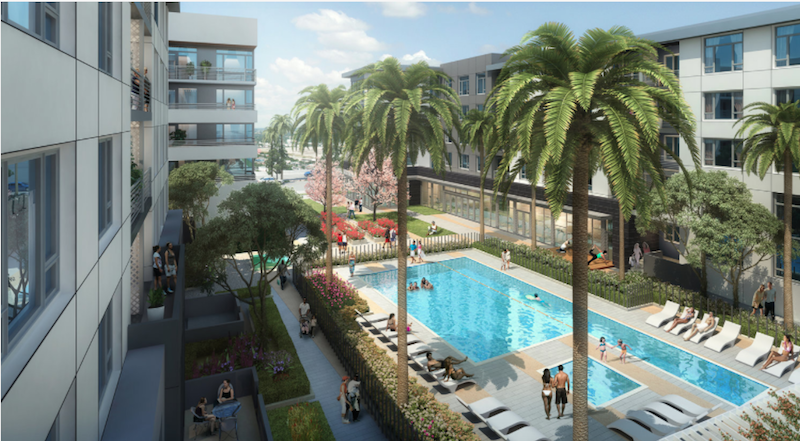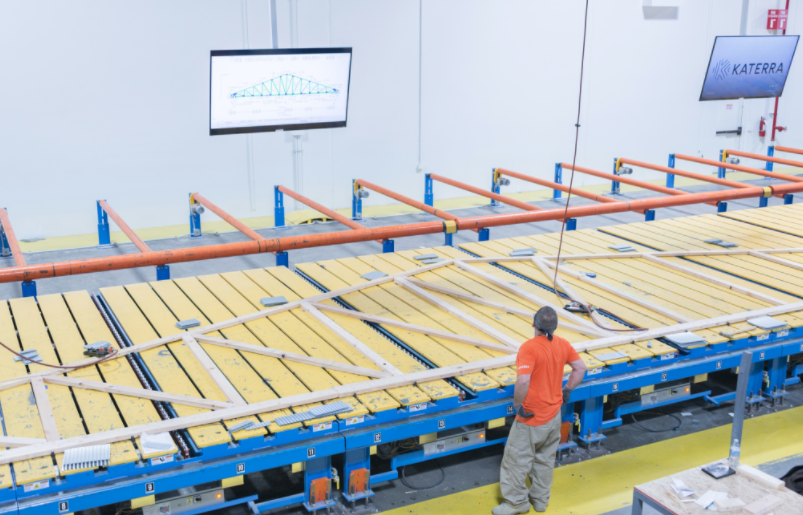By this time next year, Katerra—a technology startup whose end-to-end business model combines prefabrication, architectural, and construction services primarily for multifamily housing—expects to have six manufacturing plants up and running, including its first mass timber factory, a 250,000-sf building under construction on 29 acres in Spokane, Wash.
That plant, when fully operational in early 2019, will be capable of producing about 4.6 million cubic feet of cross-laminated timber annually. The plant’s size is comparable to CLT factories operating in Europe. “We’re going all in on CLT,” says Trevor Schick, who oversees Katerra’s supply chain, lighting, renovation, and commercial rollout activities.
Katerra’s initial success—it booked $1.3 billion in business last year—and its aggressive growth posture have attracted several high-profile investors, most prominently Japan’s SoftBank, from whose $100 billion Vision Fund Katerra recently raised $865 million in its latest round of financing.
SoftBank is steadily investing in tech-oriented companies that are impacting the built environment. In December, it paid $9.3 billion to acquire a 15% stake in Uber Technologies. It owns the robotics manufacturer and research firm Boston Dynamics. Last summer, SoftBank invested $200 million in the indoor farming enterprise Plenty. And it holds a $4.4 billion stake in WeWork, the cosharing office developer.
TechCrunch reported that the venture-capital world fully expects SoftBank to raise another $100 billion for future investments soon.
In-house design team and consortium
The Menlo Park, Calif.-based Katerra is already among the country’s largest GCs. The housing markets it serves include multifamily, senior and student living, and master-planned developments. Katerra’s largest customer is The Wolff Company, a real estate private equity firm that focuses on the multifamily sector, and whose executive chairman Fritz Wolff was one of Katerra’s Co-founders.
“Having a lead customer is important, given the investment we’re making in factories, IT, and so forth,” says Schick.
Katerra currently produces wall panels, roof and floor trusses, cabinets, and countertops from its factory in Phoenix, which began production in early 2017. That facility features Katerra’s Design Showroom, where clients can view a full suite of products and interior design solutions, including fully finished apartment units made entirely from Katerra-supplied products.
 Union Bay South in Carson, Calif., designed by Architects Orange, will offer 357 residential units, with four- and five-story wood framed buildings wrapping two separate concrete parking structures. The building, currently under construction, will include 30,000 sf of retail. Katerra is providing construction, management, and materials. Image: Katerra
Union Bay South in Carson, Calif., designed by Architects Orange, will offer 357 residential units, with four- and five-story wood framed buildings wrapping two separate concrete parking structures. The building, currently under construction, will include 30,000 sf of retail. Katerra is providing construction, management, and materials. Image: Katerra
Last June, Katerra acquired Nystrom Olson, a boutique architectural studio in Spokane. And six months later, it announced the forming of a design consortium whose members include Michael Green of Michael Green Architecture, a leader in mass timber architectural design; Andrea Leers of Boston-based Leers Weinzapfel Associates, which has also designed buildings using mass timber; Ted Flato of Lake|Flato in Texas; and Joe Greco of Lord Aeck Sargent, a full-service architecture and design firm with six offices.
With Green, Katerra is working on the design and construction of the new Hospitality Center in association with the Community Cancer Fund, Ronald McDonald House and Kootenai Health (Walden House) in Coeur d’Alene, Idaho.
Schick tells BD+C that, aside from the CLT plant in Washington, the other facilities Katerra moves into or builds this year will be conventional wood panel and truss factories. Its next mass timber plant is likely to be located in the Southeastern U.S., although Schick didn’t say when construction for that might start.
Leaning toward mass production
Katerra started as a materials supplier, with sourcing offices in Asia and Mexico. But the company soon realized that it needed a “larger scale” to get its cost model right, says Schick. That meant taking more control over the design, production, construction, and logistics of what it sold.
Technology has been the key to that transformation. Before joining Katerra, Schick spent over 15 years in the electronics industry, most recently as senior vice president at Hewlett-Packard involved in global supply chain and quality. One of Katerra’s Co-founders, Michael Marks, had been CEO of an electronics company now called Flex. A third Co-founder, Jim Davidson, founded Silver Lake, a technology investment firm.
Marks is convinced that building construction would benefit greatly from mass production techniques that are common in electronics and automotive manufacturing. Consequently, Katerra uses a kit-of-parts design system that it combines with prefabricated components production and onsite assembly.
The company’s technology platforms include SAP HANA, a market analytics platform that mines data from real estate and construction; a mobile app that connects its workforce in the field; and industrial IoT tools that optimize jobsite activity and track inventory.
 Katerra is building its first mass timber factory, a 250,000-sf building in Spokane, Wash., which will be able to produce 4.6 million cubic feet of product annually. Image: Katerra
Katerra is building its first mass timber factory, a 250,000-sf building in Spokane, Wash., which will be able to produce 4.6 million cubic feet of product annually. Image: Katerra
Schick says the company currently has 12 multifamily projects under way, ranging from 200 to 400 housing units per project. Sometime this year, he says the company plans to enter the hotel construction sector. Katerra also wants to build schools eventually.
As for projects using mass timber, Schick believes that demand among developers, contractors, and cities can only go up. He notes that the International Code Council has a vote scheduled for April to amend the 2021 International Building Code to allow for the use of CLT for buildings up to 18 stories. (Currently, CLT is limited in the U.S. to buildings no higher than six stories.)
In Washington State, ESB Bill 5450, which has passed both chambers of the legislature and is on the governor’s desk to sign, creates a section in the state statute defining qualifying mass timber products. It also directs the State Building Code Council to adopt rules for the use of mass timber in residential and commercial building, consistent with application national and international standards.
Katerra is already doing fire, earthquake, and wind sheer testing of CLT panels that it can make on its 60-foot-long by 12-foot-wide press.
Related Stories
| Dec 17, 2010
Condominium and retail building offers luxury and elegance
The 58-story Austonian in Austin, Texas, is the tallest residential building in the western U.S. Benchmark Development, along with Ziegler Cooper Architects and Balfour Beatty (GC), created the 850,000-sf tower with 178 residences, retail space, a 6,000-sf fitness center, and a 10th-floor outdoor area with a 75-foot saltwater lap pool and spa, private cabanas, outdoor kitchens, and pet exercise and grooming areas.
| Dec 17, 2010
Luxury condos built for privacy
A new luxury condominium tower in Los Angeles, The Carlyle has 24 floors with 78 units. Each of the four units on each floor has a private elevator foyer. The top three floors house six 5,000-sf penthouses that offer residents both indoor and outdoor living space. KMD Architects designed the 310,000-sf structure, and Elad Properties was project developer.
| Dec 17, 2010
Vietnam business center will combine office and residential space
The 300,000-sm VietinBank Business Center in Hanoi, Vietnam, designed by Foster + Partners, will have two commercial towers: the first, a 68-story, 362-meter office tower for the international headquarters of VietinBank; the second, a five-star hotel, spa, and serviced apartments. A seven-story podium with conference facilities, retail space, restaurants, and rooftop garden will connect the two towers. Eco-friendly features include using recycled heat from the center’s power plant to provide hot water, and installing water features and plants to improve indoor air quality. Turner Construction Co. is the general contractor.
| Dec 17, 2010
Toronto church converted for condos and shopping
Reserve Properties is transforming a 20th-century church into Bellefair Kew Beach Residences, a residential/retail complex in The Beach neighborhood of Toronto. Local architecture firm RAWdesign adapted the late Gothic-style church into a five-story condominium with 23 one- and two-bedroom units, including two-story penthouse suites. Six three-story townhouses also will be incorporated. The project will afford residents views of nearby Kew Gardens and Lake Ontario. One façade of the church was updated for retail shops.
| Dec 7, 2010
Prospects for multifamily sector improve greatly
The multifamily sector is showing signs of a real recovery, with nearly 22,000 new apartment units delivered to the market. Net absorption in the third quarter surged by 94,000 units, dropping the national vacancy rate from 7.8% to 7.1%, one of the largest quarterly drops on record, and rents increased for the second quarter in a row.
| Nov 3, 2010
Senior housing will be affordable, sustainable
Horizons at Morgan Hill, a 49-unit affordable senior housing community in Morgan Hill, Calif., was designed by KTGY Group and developed by Urban Housing Communities. The $21.2 million, three-story building will offer 36 one-bed/bath units (773 sf) and 13 two-bed/bath units (1,025 sf) on a 2.6-acre site.
| Nov 3, 2010
Rotating atriums give Riyadh’s first Hilton an unusual twist
Goettsch Partners, in collaboration with Omrania & Associates (architect of record) and David Wrenn Interiors (interior designer), is serving as design architect for the five-star, 900-key Hilton Riyadh.
| Nov 1, 2010
Sustainable, mixed-income housing to revitalize community
The $41 million Arlington Grove mixed-use development in St. Louis is viewed as a major step in revitalizing the community. Developed by McCormack Baron Salazar with KAI Design & Build (architect, MEP, GC), the project will add 112 new and renovated mixed-income rental units (market rate, low-income, and public housing) totaling 162,000 sf, plus 5,000 sf of commercial/retail space.
| Nov 1, 2010
Vancouver’s former Olympic Village shoots for Gold
The first tenants of the Millennium Water development in Vancouver, B.C., were Olympic athletes competing in the 2010 Winter Games. Now the former Olympic Village, located on a 17-acre brownfield site, is being transformed into a residential neighborhood targeting LEED ND Gold. The buildings are expected to consume 30-70% less energy than comparable structures.
| Oct 13, 2010
Apartment complex will offer affordable green housing
Urban Housing Communities, KTGY Group, and the City of Big Bear Lake (Calif.) Improvement Agency are collaborating on The Crossings at Big Bear Lake, the first apartment complex in the city to offer residents affordable, eco-friendly homes. KTGY designed 28 two-bedroom, two-story townhomes and 14 three-bedroom, single-story flats, averaging 1,100 sf each.
















